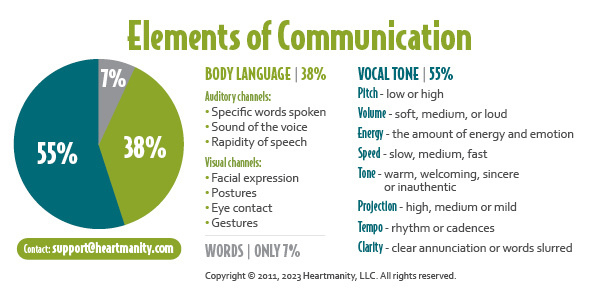In today's competitive market, companies must stand out to be successful. And leaders need to lead effectively to aspire purpose, right action, and retain their talent. With the dramatic rise of virtual meetings and digital interactions, the importance of personal connections is often overlooked—even forgotten.
However, one kind of communication that plays a crucial role in our interactions in the workplace is nonverbal communication. It's a silent language packed with valuable intel. Every great leader has fine-tuned their communication style with empathy and mastered nonverbal cues!
Estimated reading time: 7 minutes
 What Is Nonverbal Communication?
What Is Nonverbal Communication?
Self-explanatory, right?
No words.
Yet, when we think of communication, we normally think of talking and conversing.
As you probably already know, only seven percent of communication is words, the rest is nonverbal. It's a huge mistake to depend on that seven percent!
In my two decades of experience training leaders in emotional intelligence, this area is sorely lacking. Mastering nonverbal cues is a goldmine when it comes to eliminating problems in leadership communication.
So, what does nonverbal communication encompass? Basically, anything conveying a message without words. Here is a list of the most common types.
- facial expressions
- gestures
- posture
- head position
- eye contact
- proximity to others.
One way to truly appreciate the power (and subtlety) of nonverbal communication is to compare it to the background music of a good movie. It sets the tone, conveys the mood, and alerts the viewer of something to come. We often don't even notice music in movies because it matches the story and plot so well.
Nonverbal cues are so integral to everyday interactions that, unfortunately, we've stopped paying attention to them. We've stopped noticing.
Consider a scenario where you're conversing with a colleague at work and you sense a hint of doubt or hesitation in their nonverbal cues. These are the silent exchanges we often overlook. We move on and pretend it was nothing.
In professional settings, being attuned to these cues not only enhances understanding but also fosters a more authentic and open work environment. Many leadership mistakes can be avoided by being more attentive to body language.
Related reading: "Authentic Leadership Versus Micro-Management: Reasons Why It Matters!"
Key Elements of Nonverbal Communication
As a leader, mastering nonverbal communication is crucial. When we listen behind the words and are alert for nonverbal signals, it paves the way for employees to share their true opinions, leading to more honest and productive discussions.
Here's a helpful chart to depict the aspects of nonverbal communication.

The Impact of a Leader's Body Language in Shaping Perceptions
Our body language often speaks louder than our words. The way we sit, stand, or move can convey confidence and openness or defensiveness.
For instance, as a leader if you enter a meeting stressed with a scowl, it could be construed that you're unhappy with performance. When employees are talking, if you're surfing your phone, it communicates disinterest.
Let me give you a powerful example of a lack of awareness by a leader.
A couple of years ago, I was leading a mediation with C-Suite leader and his direct reports to resolve a reoccurring issue. In the center of the room was a large oval wood table surrounded by office chairs. As everyone entered, the VP took a seat on the long side of the table, not the head. Then, he chose a chair that was extremely low and its mechanics dysfunctional; it even tilted to the side a bit. The other six employees peered over him while seated.
Was this leader eluding confidence? And did he assert his authentic power while honoring his mantle as a leader by his seating choice? Nope!
As he wobbled in the chair, it squeaked along with his deflated poise and soft-spoken voice.
How can a leader inspire and command respect when confounded by a chair!?
That's an example of how nonverbal communication can disempower leaders.
Being mindful of body language and aware of what we are communicating in the workplace is far more vital than most people realize. Emotionally intelligent leaders emit confidence, purpose, and motivate the people around them by their stature alone. Companies who retain talent train their leaders to raise their EQ.
Secondly, aligning body language with your verbal messages can significantly impact how others perceive and respond to you.
Research supports that nonverbal cues play a pivotal role in effective communication, with studies suggesting that a significant portion of our communication is transmitted through nonverbal behaviors.
In one study, the way leaders held themselves and communicated nonverbally vastly influenced employees' perception of them.
Leaders’ nonverbal behavior was linked to perceptions of their receptivity, formidability, and charisma in study 2. At the brain systems level, studies 3a and 3b tested predictions that charismatic nonverbal performances stimulate equivalent degrees of approach and avoidance motivation in observers.
Other conclusions indicated in research:
- Competence is shown through good eye contact.
- Eye contact portrays honesty.
- Mumbling and low projection of voice eludes a lack of confidence.
- Leaders who don't allow employees to finish speaking, interrupt, or talk too much
are thought to be uninterested in others' opinions and dismissal. - The warmth of a leader translates to receptivity.
Related reading: "Consequences of a Lack of Communication in the Workplace."
What Leaders Can Do to Sharpen Awareness of Nonverbal Cues
Awareness of one's nonverbal communication and the willingness to adapt and refine this silent language is crucial. Leaders can start by seeking feedback on their nonverbal cues and observing the nonverbal behaviors of leaders they admire.
Leaders adept at reading nonverbal signals can better understand and connect with their team members, discerning unspoken concerns or emotions. This level of empathy and understanding is crucial in building a supportive, cohesive team dynamics. The ability to decode and appropriately respond to the nonverbal cues of others is a hallmark of empathetic leadership.
Observe Facial Expressions
Facial expressions are powerful indicators of the person's emotions. A genuine smile can build rapport while a furrowed brow can express concern, confusion or dismay. Paying attention to others' facial expressions and managing your own, can communicate empathy, sincerity, and greater understanding.
Make Friendly and Direct Eye Contact to Establish Trust and Connection
Eye contact is a critical component of effective nonverbal communication. It can convey confidence, honesty, and interest. Maintaining appropriate eye contact demonstrates that you are fully engaged and present, which can strengthen trust in both personal and professional interactions. However, it's important to balance eye contact to avoid making others feel uncomfortable.
Raise Your Awareness of Your Posturing
Mastering nonverbal communication begins with self-awareness. Take time to observe your nonverbal cues and consider how they might be interpreted by others. Nonverbal cues like positive body language and open gestures can amplify a message of inspiration and vision. Simply by relaxing your body before entering a meeting or discussing a problem with a manager will soften your approach.
Practice aligning your body language with your words to convey clear and consistent messages. Also, be mindful of cultural differences in nonverbal communication to avoid misunderstandings.
Lower Misinterpretation by Heightening Nonverbal Skills
Misinterpretation is a common challenge in nonverbal communication. It is a major time waster in companies and among teams. To overcome this disconnect, seek clarification when you notice a discrepancy between verbal and nonverbal messages.
For instance, a manager is asked to complete a task and they agree. However, their body language says differently: eyes looking away, lowered energy in words, a sigh and discouraged facial expression.
You check in with this employee above and you find out that he disagrees with the assignment. He even believed that the request shouldn't be done at all and considers it busy work. But if it needs to be done, it would be better delegated to one of his team. Now, you learn new information and a fresh in-the-trenches-viewpoint that sheds light on the subject.
Ask open-ended questions to explore the underlying feelings and thoughts. Additionally, hone your observational skills to notice when words don't match body language. By becoming more aware of our own nonverbal cues and learning to read others' signals, we can navigate the complexities of communication more effectively.
Closing Thoughts
Nonverbal communication is a powerful tool that, when mastered, can enhance our interactions and relationships significantly. Understanding nonverbal subtleties can prevent misinterpretations and foster a more inclusive environment. Leaders who are adept at adjusting their nonverbal communication to respect cultural differences can build stronger, more diverse teams.
Mastering nonverbal communication is not merely an optional skill for leaders; it's an imperative. The subtleties of body language, facial expressions, and gestures offer a profound way to connect, inspire, and lead with authenticity and empathy.
Visit Heartmanity for Business to learn more about our services. If you'd like to hire Jennifer for executive coaching or leadership training, contact us!








